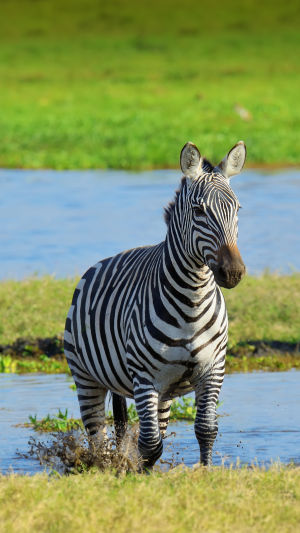Zebras, known as short-footed horses, are herbivorous mammals found in Africa, renowned for their iconic black and white striped appearance. They inhabit grasslands and scrublands and possess remarkable speed and adaptability.
Belonging to the equine family, which includes horses, donkeys, and wild horses, zebras are taxonomically classified under the genus Equus.
While they share common characteristics and kinship with other equines, zebras stand apart with their distinctive black and white striped fur, setting them apart from their counterparts.
The black and white stripes are the most recognizable feature of zebras, with each zebra possessing a unique pattern akin to human fingerprints.
These stripes not only aid in individual recognition within grasslands but also serve as a means to confuse predators such as lions and jackals, making it challenging for them to discern the number and direction of zebras.
Zebras are medium-sized mammals, standing approximately 1.2 to 1.4 meters tall at the shoulder and weighing between 200 and 450 kilograms.
Their physical structure is adapted for prolonged running and evading predators. Grazing on grass, zebras often gather in large herds, enhancing defense and foraging opportunities.
Zebras play a vital role in the ecosystem, particularly in grassland habitats. They contribute to the ecological balance by consuming tall grass and preventing overgrowth. Additionally, they serve as a food source for numerous predators.
Despite being relatively common in Africa, zebras face various threats. Habitat loss, hunting, and illegal trade have adversely affected their population and natural habitats. Conservation initiatives and projects are in progress to safeguard this valuable species.
Zebras are emblematic African animals, cherished for their distinctive appearance and ecological significance. Collaborative efforts are necessary to protect them, ensuring their survival and reproduction in their natural habitats.
During the evolutionary process, zebras and horses diverged from a common ancestor between 40,000 and 4.7 million years ago, adapting to their respective environments.
In early human societies, wild horses in North America and Europe were domesticated for various purposes, including as a food source.
As time passed, humans gained a better understanding of horse behavior and their diverse capabilities.
Recognizing the importance of horses in transportation and warfare, humans invested time and effort in selectively breeding horses with the most docile traits to produce offspring. This led to the complete domestication of horses by humans.
In contrast to wild horses, zebras residing in the expansive African savannah face numerous natural enemies and predators, including formidable lions, swift cheetahs, and cunning hyenas.
Natural selection shaped zebras into high-alert and agile creatures, quick to flee at the slightest sign of danger.
As a result, zebras possess a strong aversion to being captured and exhibit surprising defensive capabilities, such as the ability to deliver lethal kicks, even against attacking lions.
Attempts to capture zebras have revealed their exceptional speed and coordinated evasive reflexes, posing significant challenges for individuals using lassos or other capture methods.
Unlike wild horses that live in structured family groups with clear hierarchies, zebras lack a defined family structure or hierarchy. This absence of social order represents a primary obstacle to their domestication by humans.





